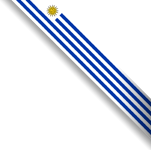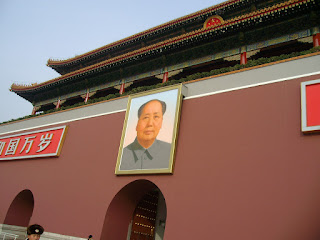The Forbidden City, palace of Chinese emperors for about 500 years, is located in the centre of Beijing, the capital of China. The complex of 980 buildings constructed mostly of wood occupies 720 000 m². Formerly was completely prohibited the visits of people who did not belong to the court so to visit it today is a great historic achievement :)
Fachada de La Ciudad Prohibida con un retrato gigante de MAO sobre la entrada.
Facade of The Forbidden City with a giant portrait of MAO on the entry.
Para llegar se puede tomar un bus o el metro. La estación de metro queda cruzando la calle, hacia la derecha : Tian'an men dong o Tian'an men xi, línea 1.
El precio es muy accesible como la mayoría de los lugares para visitar en China: 10 dólares en temporada alta (desde abril hasta octubre) y de 6,50 dólares en temporada baja (desde noviembre hasta marzo), niños pequeños entran gratis. En China no hacen diferencia de precios para extranjeros y locales lo que hace que las entradas sean muy económicas para nosotros.
Dicen que en temporada alta está abarrotada de gente lo que dificulta disfrutar su visita. En mi caso, como fui en diciembre, lo único que molestaba realmente era el frío ( a veces ¡-8 grados C al mediodía!)
To get there you can take a bus or subway. The subway station is across the street, to the right: Tian'an men dong or Tian'an men xi, line 1.
The price is very accessible as most of the places to visit in China: $ 10 in high season (April to October) and $ 6.50 in low season (November to March), children are free. China makes no difference in price for foreigners and locals making the entries very economical for us.
They say that in high season is crowded making it difficult to enjoy your visit. In my case, I went in December so the only thing that bothered really was the cold (sometimes -8 degrees C at noon!)
Aquí se compran las entradas y algún snack/ Here you buy the tickets and some snack.
Desgraciadamente los pabellones están cerrados y a oscuras. Apenas se puede ver su interior desde afuera. De todos modos solamente prevalecen los tronos y algún que otro mueble poco conservado.
Unfortunately the pavilions are closed and dark. You can barely see inside from outside. Anyway prevail only the thrones and an occasional furniture little preserved.

Gran plaza con el Salón de la Armonía Suprema al fondo/ Great square with the Hall of Supreme Harmony in the background.
Los techos son hermosos, la mayoría hecho de tejas amarillas ya que es el color del emperador.
The ceilings are beautiful, most of them made with yellow tile because it is the colour of the emperor.
The ceilings are beautiful, most of them made with yellow tile because it is the colour of the emperor.
Al igual que ocurre en la mayoría de los edificios tradicionales chinos, leones guardan la entrada a cada uno de los pabellones.
As is the case in most traditional Chinese buildings, lions guard the entrance to each of the wards.
As is the case in most traditional Chinese buildings, lions guard the entrance to each of the wards.
Es impresionante ver la cantidad de mármol blanco que se utilizó en los patios y poder cruzar los pequeños puentes hechos completamente de este marmol.
It's amazing the amount of white marble that was used for making the courtyards and to cross the bridges completely made of this marble.
It's amazing the amount of white marble that was used for making the courtyards and to cross the bridges completely made of this marble.
La puerta son de madera maciza y decoradas con filas de clavos dorados.
The doors are made of solid wood and decorated with rows of golden spikes.
The doors are made of solid wood and decorated with rows of golden spikes.
En los patios se pueden apreciar algunas esculturas muy hermosas.
In the courtyard you can apreciate some very beautiful sculptures.
In the courtyard you can apreciate some very beautiful sculptures.
En esta foto se puede ver cómo la gente mira el interior de los pabellones a través de las ventanas.
In this picture you can see how people look inside the halls through windows.
Y por último, algo que me gustó mucho en China: la limpieza de los museos y palacios. El señor de la limpieza vestía un uniforme parecido al de los cosacos rusos :)
And finally, something that I really liked in China: the cleaning of the museums and palaces. The cleaning guy was wearing an uniform similar to Russian Cossacks :)
And finally, something that I really liked in China: the cleaning of the museums and palaces. The cleaning guy was wearing an uniform similar to Russian Cossacks :)


















Nice pictures and nicely explained about the things and places.
ResponderEliminarThank you for your comment :)
Eliminar